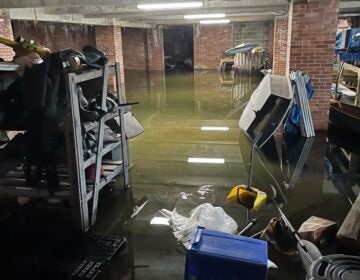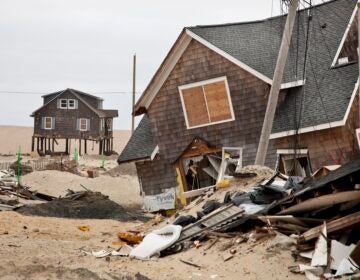Experts recommend ‘road salt diet’ as snowstorm hits the Philly region
While salt makes it safer to walk and drive, it can also pollute waterways, soil and groundwater.

FILE - A truck laid salt on Philadelphia roads during a winter storm Jan. 6, 2025. (Kimberly Paynter/WHYY)
From Philly and the Pa. suburbs to South Jersey and Delaware, what would you like WHYY News to cover? Let us know!
As frigid temperatures and snow hit the region, tons of salt will be applied to roads, parking lots, driveways and sidewalks.
Road salt improves safety for drivers and pedestrians. However, it can run off roads and driveways when the snow melts or when it rains, polluting waterways. Salt dumped on roadsides can also seep into soil and groundwater.
Road salts, which contain chloride, can reduce oxygen levels in waterways, threatening fish and other species. The salt can also contaminate private water wells and cause health problems for people with high blood pressure, according to the Environmental Protection Agency.
The impacts are long lasting — road salt can stay in the environment for decades.
Towns, counties and states can reduce their impacts by applying brine, which uses less salt, or by applying salt conservatively, said Amanda Carneiro Marques, a professor of civil and environmental engineering at Drexel University who has studied the impacts of road salt.
Residents and businesses can also make a difference, she said.
“If everyone can be aware of the implications, and implement some strategies that have these benefits for the environment, that would help a lot,” Carneiro Marques said.
Some studies have found that private salt application rates are several times higher than the rates used by public road maintenance agencies.
A Villanova University peer-reviewed study published last year showed road salts impacted Chester County waterways by increasing salinity and metal concentrations in the water.
It’s difficult to pinpoint the sources of road salt pollution in waterways, however.
Researcher Steven Goldsmith, an environmental science professor at Villanova University, said residents can also put their own property on a “salt diet.”
“One way to do that would be to use no more than one coffee mug for every 10 sidewalk squares on your property,” he said.
When there’s less snow than predicted, Goldsmith said a good way to keep it out of waterways is to sweep up the unused salt so it doesn’t run off into local streams.
Carneiro Marques said because road salt can remain in the environment for decades, it may take a while to see improvements.
“Depending on how the system works, and how long the salt is stored in the soils of the subsurface, we can still see a release of salt over time. So that’s why it’s important for us to start acting now to improve these trends,” she said. “But at the same time, it might take some time until we see an effective reduction of these trends and an improvement in the environmental conditions.”
The Pennsylvania Department of Transportation uses an average of more than 800,000 tons of salt during the winter.

Get daily updates from WHYY News!
WHYY is your source for fact-based, in-depth journalism and information. As a nonprofit organization, we rely on financial support from readers like you. Please give today.





